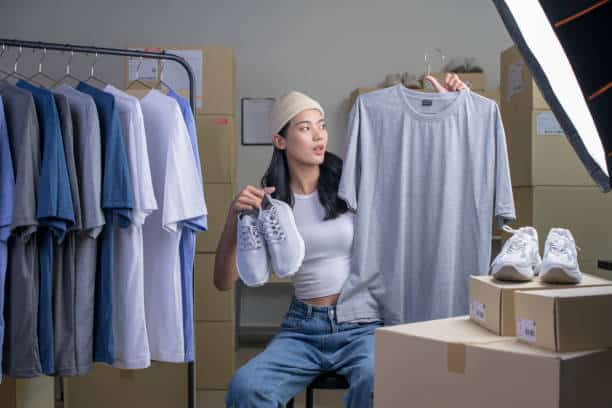How to get your clothing designs made? Starting your fashion line is exciting because it is a process of bringing your creativity out of the drawing board into fashion clothing. Starting a clothing line means spending heaps of time focusing on brainstorming and designing clothes that would attract an intended audience. But with the right amount of attempts, correct information and tools then it is definitely very possible.
The following guidelines are designed to guide a fashion designer through the fundamental concepts of the process of how to get clothing designs made and made professionally. Let’s swim into the fashion world and help you make all the dreams come true.
1. Start with a Clear Design Vision
Like any great line of clothing, every clothing line has to begin with a mighty concept. This is where you tell your audience exactly who your brand or collection is for. Your vision should encompass:
- Target audience: Who is your ideal customer? Consider their ages, styles, the way they live, and what type of products they usually purchase.
- Inspiration: Can you explain your ideas when creating this collection? In whatever fashion you are borrowing from street wear or vintage wear or even haute couture the theme should be distinct and well defined.
- Brand Identity: Are you launching a sustainable line, or are you more interested in luxury fashion? Your brand image has to guide all your designs and business strategies.
After, you’ve set your vision, draw diagrams of the designs or make some graphics interfaces of the layout. For digital designing some tools include Adobe Illustrator, Procreate, and fashion designing software like CLO 3D or TUKAcad.
2. Create a Tech Pack
Originally, a tech pack (or technical pack) is the technical plan of your product, so to speak. It encompasses all the important information any manufacturer will require in order to realize your great idea. Your tech pack should include:
- Sketches/Design Illustrations: Front, back, and side views.
- Fabric Details: Describe the type of fabric you want, the fabric material, the fabric weight and any characteristics that you feel are necessary.
- Measurements and Sizes: Exact measurements of each size which you plan to manufacture.
- Trims and Accessories: Any other parts such as buttons, zippers or any other additional accessory to be placed on the garment.
- Stitching and Construction Notes: Additional details important for the assembly, including certain kinds of stitches or seam allowances, for example.
- Colorways: Provide separate descriptions of colour such as fabric samples or giving a Pantone number for hue variations.
The tech pack has the added advantage of eliminating any misunderstandings that may be likely to happen between the pattern maker, the manufacturer and you. It becomes your key working tool to liaise with the factory as well as organise its chain of supply and production arrangement.
3. Choose Your Fabrics and Materials
It is equally important to choose the right fabric through which to realize the design for your clothing. Fabrics decide the feel, the appearance, the behaviour of the clothes, its sustainability, and even how it should be managed.
Research Fabrics:
Clothes such as cotton, silk, polyester or wool, different in their behaviour, so it is also advisable to find out more about them. This should include such factors as the density, such properties as breathability, texture and price.
Order Swatches:
If the latter is the case, fabric suppliers allow you to ask for swatches, or limited samples of the material to touch and feel.
Sustainability Considerations:
When looking for sustainable fabrics or fabrics that have a lesser environmental impact, there are few things that you should know: Organic cotton, Recycled polyester, Tencel and Bamboo fabrics. There are specific certificates which can assure ecological cleanliness, for example, OEKO-TEX or GOTS.
When selecting your fabrics, it is critical to know that the quality of the fabric is virtually the key to the outcome of your finished product.
4. Find a Reliable Manufacturer
After designing a clothing line, choosing the appropriate fabrics, the next important step to take is to look for a manufacturer who will actually make your clothes. Here’s how:
- Types of Manufacturers:
- Cut, Make, Trim (CMT) Manufacturers: They expect you to supply all the materials, and wait while they sew the garments together for you.
- Full Package Production (FPP) Manufacturers: These factories coordinate from the fabric purchase to garment production, and are perfect for new designers.
- Research Potential Factories: Choose companies that focus on producing specific types of clothing that you would like to create, such as urban wear, sports wear or formal wear. Think about whether you want to source your product from a domestic or an international manufacturer company (each has its advantages and disadvantages).
- Contact and Request Samples: After you shortlist the manufacturers, you want to get in touch with them and request samples, or prototypes to discuss the quality of work. Make sure you hand over your tech pack as this will enable them create a genuine sample for you.
- Factors to Consider:
- Minimum Order Quantity (MOQ): Minimum quantity is also set by some manufacturers which should be in accordance with your requirement for production.
- Lead Times: Make sure the factories’ production schedules correspond with your time line especially if you are to release a new line during some certain period of the year.
- Pricing: So price is not the only factor to look into; other factors include quality, reliability, and communication.
Establishing a good relationship with a trustworthy manufacturer is among the most important procedures that need to be followed in order to produce designs into fine apparels.
5. Create Prototypes and Samples
Making a sample or a prototype before going into full production run is nonetheless necessary. This will help you:
- Evaluate Fit and Function: Check that the fit of the garment is correct and comfortable to wear.
- Test Construction Quality: You should ensure that every stitch, seams, and construction of it meets your expectations.
- Refine Your Design: Occasionally, the first prototype may not be refined and this will give an opportunity to make adjustments in the design before going to the production line.
In most of the cases your manufacturer will develop their samples based on the tech pack that you provided. This means that you have to prepare for multiple trips to the fitting area to have samples done and receive feedback before coming up with the desired garment.
6. Grading for Sizes
The next level after getting the sample perfectly has to do with grading of the sample for different size. Grading is the step that ensures that the pattern can be enlarged or reduced in size so as to make it in different sizes without compromising on the looks and the correct size for the garment.
Size Ranges:
Another decision drivers are the options in regards to sizes that one wants to establish. This predominantly depends with the market and could range from a simple XS to XL or probably even much higher.
Grade Rules:
Seek the services of a professional pattern maker to add the grade rules which state the amount by which a pattern must expand or contract between sizes. This is for the purpose of keeping the correct size to size ratio and reduce size distortions.
Some of the reasons why grading is an essential aspect include: Good grading is vital to uphold the looks, as well as general appearance of garments with respects to a particular design.
7. Place Your Production Order
Once your samples are approved and your designs are graded then it is time to place your order for production. This is the time you allocate certain units of each style and size that you want to produce.
- Minimum Order Quantities (MOQ): Ensure that you have agreed on the MOQ with your manufacturer and ensure that it falls within your financial parameters.
- Quality Control: Establish a quality control plan for the garments such that quality does not deteriorate in the course of garment production. Some designers even have to outsource quality control personnel for the job for mass production.
The production of the T-shirts takes between few weeks to few months depending with the level of design that you want to be produced and the number of T-shirts that you want to be produced.
8. Labeling and Packaging
However, when selling your garments it will be important to determine how you wish to brand your garments and pack them for sale in stores or online.
Labels:
Choose your brand label, care label and size label. These usually hang at some part of the garments and include information such as; washing instructions, material content, and your brand emblem.
Hang Tags:
Hand tags are the tags found at the outer side of the garment and they are priced, bar coded and branded. It is another potential to give people an insight into your brand.
Eco-Friendly Packaging:
However, if sustainability is something that your brand values, you should use recyclable or biodegradable packaging. Presently many consumers have a preference for brands that do not contribute to the generation of more waste.
Package does not only defend your garments but also play a big role in the perceived quality, customer satisfaction and brand recall.
9. Launch and Market Your Collection
After reading the lessons that we have drawn up and creating your clothing line, it is now time for you to expose them to the world. This is the phase where you will be promoting and distributing your garments.
- Build a Website or Online Store: If you do not have it yet, set yourself up an online store or a website with popular platforms like Shopify, Etsy or BigCommerce. Making an online store should follow your brand image and the online store should provide a perfect shopping experience.
- Social Media Marketing: Share your designs on Instagram, TikTok, Pinterest, and Facebook. They enable you to have followers, target consumers, and marketing of the garments through pictures, and short or long narratives.
- Collaborations and Influencers: You should think about partnering with influencers or other brands to expand reach. Influencers come in handy when you want to bring your clothing line to audiences you may not have reached yet.
- Pop-Up Shops and Fashion Shows: You should begin your line with something tangible, this could be a fancy show or a booth somewhere. This can cause hype and can help people get a chance to see your garments in the flesh Originally posted by fashionside.com(feedspot.com).
Conclusion: Bringing Your Designs to Life
The process of evolving a concept of clothing designs to a developed collection is exciting and involves a huge learning curve. It’s a process that, although long, is not complicated and if one takes it in chunks: coming up with your vision, developing a tech pack, selecting fabrics, seeking out a manufacturer and starting your line it is very doable.
The fashion industry is saturated, but with hard work, ideas and the tools, it is possible to create a niche for yourself. As I have said, any big brand begins the same way you are today—so go on!




